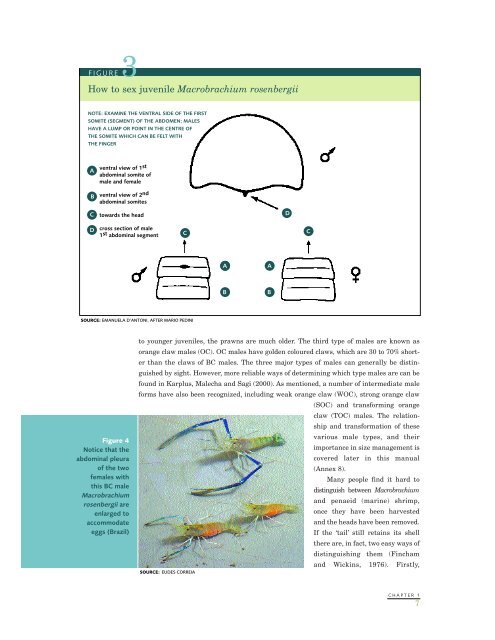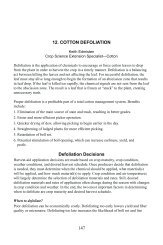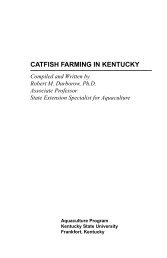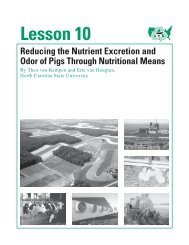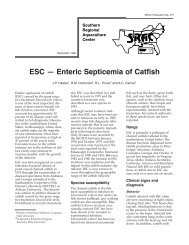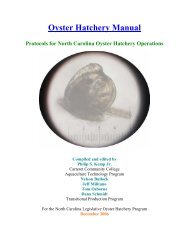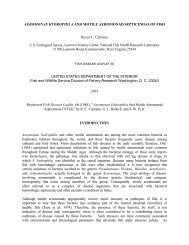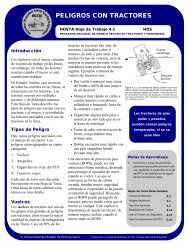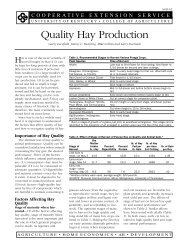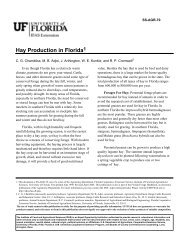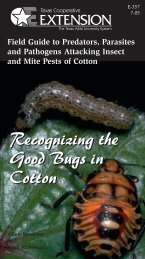Farming freshwater prawns A manual for the culture of ... - eXtension
Farming freshwater prawns A manual for the culture of ... - eXtension
Farming freshwater prawns A manual for the culture of ... - eXtension
You also want an ePaper? Increase the reach of your titles
YUMPU automatically turns print PDFs into web optimized ePapers that Google loves.
FIGURE3<br />
How to sex juvenile Macrobrachium rosenbergii<br />
NOTE: EXAMINE THE VENTRAL SIDE OF THE FIRST<br />
SOMITE (SEGMENT) OF THE ABDOMEN; MALES<br />
HAVE A LUMP OR POINT IN THE CENTRE OF<br />
THE SOMITE WHICH CAN BE FELT WITH<br />
THE FINGER<br />
1. ventral view <strong>of</strong> 1<br />
A<br />
st<br />
abdominal somite <strong>of</strong><br />
male and female<br />
2. B ventral view <strong>of</strong> 2 nd<br />
abdominal somites<br />
C3. towards <strong>the</strong> head<br />
D<br />
D4. cross section <strong>of</strong> male<br />
1 st abdominal segment<br />
C<br />
C<br />
A<br />
A<br />
B<br />
B<br />
SOURCE: EMANUELA D’ANTONI, AFTER MARIO PEDINI<br />
Figure 4<br />
Notice that <strong>the</strong><br />
abdominal pleura<br />
<strong>of</strong> <strong>the</strong> two<br />
females with<br />
this BC male<br />
Macrobrachium<br />
rosenbergii are<br />
enlarged to<br />
accommodate<br />
eggs (Brazil)<br />
to younger juveniles, <strong>the</strong> <strong>prawns</strong> are much older. The third type <strong>of</strong> males are known as<br />
orange claw males (OC). OC males have golden coloured claws, which are 30 to 70% shorter<br />
than <strong>the</strong> claws <strong>of</strong> BC males. The three major types <strong>of</strong> males can generally be distinguished<br />
by sight. However, more reliable ways <strong>of</strong> determining which type males are can be<br />
found in Karplus, Malecha and Sagi (2000). As mentioned, a number <strong>of</strong> intermediate male<br />
<strong>for</strong>ms have also been recognized, including weak orange claw (WOC), strong orange claw<br />
(SOC) and trans<strong>for</strong>ming orange<br />
claw (TOC) males. The relationship<br />
and trans<strong>for</strong>mation <strong>of</strong> <strong>the</strong>se<br />
various male types, and <strong>the</strong>ir<br />
importance in size management is<br />
covered later in this <strong>manual</strong><br />
(Annex 8).<br />
Many people find it hard to<br />
distinguish between Macrobrachium<br />
and penaeid (marine) shrimp,<br />
once <strong>the</strong>y have been harvested<br />
and <strong>the</strong> heads have been removed.<br />
If <strong>the</strong> ‘tail’ still retains its shell<br />
<strong>the</strong>re are, in fact, two easy ways <strong>of</strong><br />
distinguishing <strong>the</strong>m (Fincham<br />
and Wickins, 1976). Firstly,<br />
SOURCE: EUDES CORREIA<br />
CHAPTER 1<br />
7


